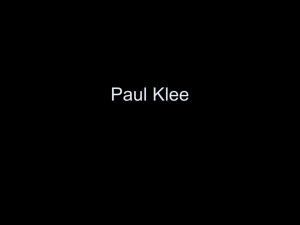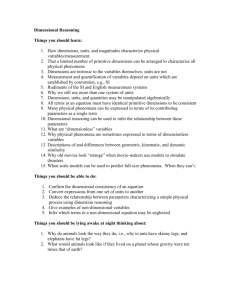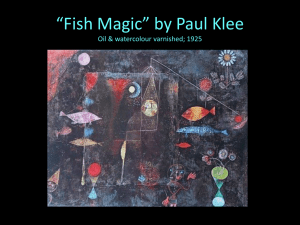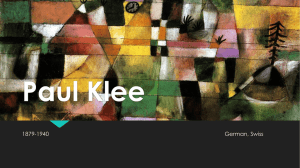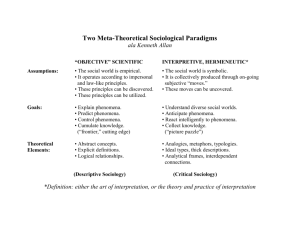Some Mechanical and Metaphysical
advertisement
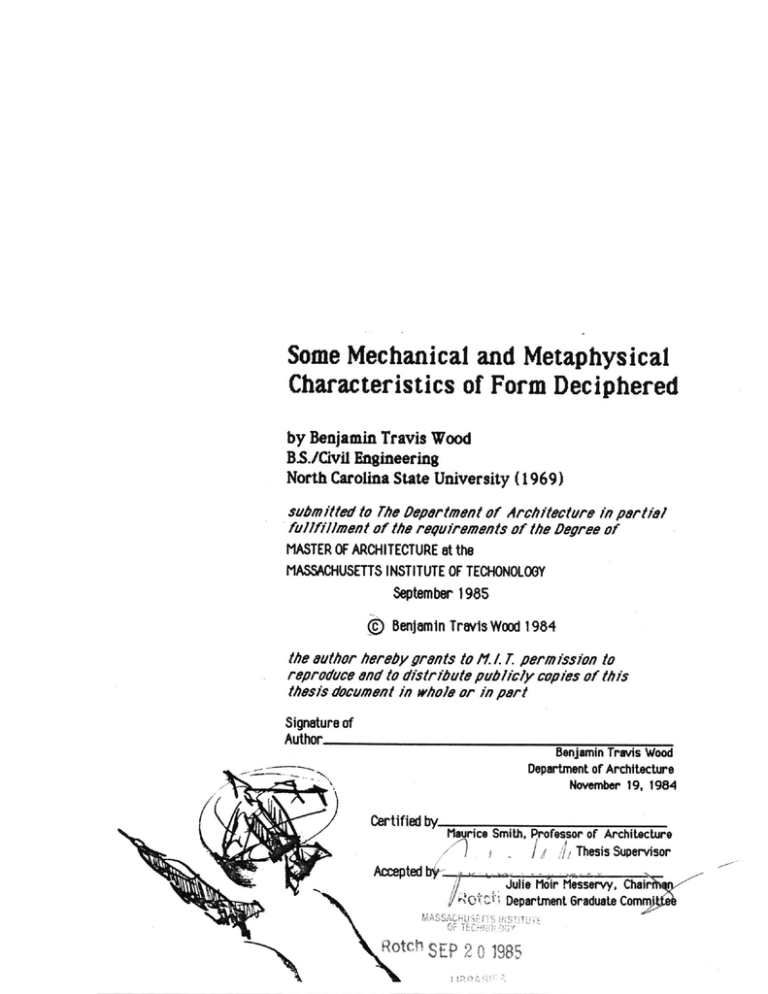
Some Mechanical and Metaphysical Characteristics of Form Deciphered by Benjamin Travis Wood B.S./Civil Engineering North Carolina State University (1969) submitted to The Department of Architecture in prtfial fulilfilment of the requirements of the Degree of MASTER OF ARCHITECTURE at the MASSACHUSETTS INSTITUTE OF TECHONOLOGY September 1985 Benjamin Travis Wood 1984 the author hereby grants to M./. T.permission to reproduce and to distribute publicly copies of this thesis document in whole or in part Signature of Aulthor Benjamin Travis Wood Department of Architecture November 19, 1984 Certified b Maurice Smith, Professor of Architecture Thesis Supervisor Accepted b Julie Moir Messervy. Chai ROQtZ~ Department Graduate Com' MoAStSHU2,0,98T Rotch SEP 2 01985 MITLibraries Document Services Room 14-0551 77 Massachusetts Avenue Cambridge, MA 02139 Ph: 617.253.2800 Email: docs@mit.edu http://libraries.mit.edu/docs DISCLAIMER OF QUALITY Due to the condition of the original material, there are unavoidable flaws in this reproduction. We have made every effort possible to provide you with the best copy available. If you are dissatisfied with this product and find it unusable, please contact Document Services as soon as possible. Thank you. The images contained in this document are of the best quality available. 1 1 TABLE OF CONTENTS: 2 ABSTRACT: 6 THESIS: 40 BIBLIOGRAPHY: 1.Mechanical Understanding of Form: Pictorial Depth Robert Venturi / begin where 8/ pictoriml form begins, with the point tht sets itself into motion. Paul Klee historic, two-dimensional framework Paul Klee Paul Klee "traces" of Minos Paul Klee Kurt Krantz trace serializtion Problematic discontinuities Symbolic Autonomy To build a rocket ad send it to the moon, you need only to measure space......not define it. Roger Jones Depth, a Rennaissance idea Big Creek, October 2 Some Mechanical and Metaphysical Characteristics of Form Deciphered Robert Venturi by Benjamin Travis Wood II. Metaphysical Understanding: Transcendental Depth Submitted to the Department of Architecture on November 19, 1984 in partial fulfillment of the requirements for the Degree of Master of Architecture. Egocentric "here and there"_ ABSTRACT we know we exist. Merleau-Ponty Mirror Man and the other side Incongruent counterparts Immanuel Kant Extra-Dimensional Behavior inside end outside the ego Paul Kies Big Creek, November Ill. Boundaries Human-centric hierarchy there is no future... whether the earth or the sun revolves around the other is a matter ofprofound indifferenc. Albert Camus terrItor/el presence of 8ctuei//ties George Herbert Mead Scientific/mathematical abstraction does not fix the limits and constraints within which a designer may operate. Nor should it be necessary to understand form generation as a defiant, self-expressive gesture outside those boundaries. Both are predilections of mutually exclusive, formal frameworks. Some characteristics of these frameworks, a mechanical and metaphysical understanding (respectively), are deciphered and a philosophic alternative is partially exposed. A world of phenomena exists independent of humankind and another, one of ideas, is dependent on humankind. Built environments manifest a relationship between these worlds.... and proffer an organic hypothesis: a design philosophy need not transcend the archetypal ubiety of physical phenomena. The dark side is a naive desire to transfix time, to overcome Angst. An alternative is to associate "I" with field (behavior] as a variable, moving, changing phenomena of form. Carlos Scarpa Robert Venturi Jaspers SIeep of fe/th Maurice Smith, Thesis Supervisor Professor of Architecture 3 where e1 is order and symmetry there con be no life Lancelot Law Whyte CrtiOn, pr5 Vetion, deth Kurt Krantz Immanuel Kant Robert Pirsig Depth, the other side of seeing Prepositions of Inhabitation Big Creek, December Tautochronistic shifts an Outrageous Polemic Not end now, now end not, not end now Gertrude Stein Aldo van Eyck Dylan Thomas Finite Boundaries, Frames the isend, thus, is e piece per exce//ence Norberg-Schulz IV. Both Sides [Now] Beyond Figure/Ground "I"as a variable, moving,, changing, phenomena of Form 4 8 rose is 8 rose Is 8 rose Gertrude Stein Albert Einstein Leeward Conundrum Ink blot Anatomy Is there 8n exchange, is there In a corner of Oklahoma, a woman is plucking at the earth. She is naked, and gardening. She has land all over her, for she has also been making pots, and her long Bohemian hair is blondly gummy with clay. She kneels down and messes with a place in the earth. resemblance to the sky which is admitted to be there end the stars which can be seen. Gertrude Stein spatial pssings in a cogredient world George Herbert Mead James Dickey Geography, not geomety, is good to us. Architecture belongs more to a world of phenomena than of ideas. Henri Bergson A. N.Whitehead Gertrude Stein Let Us /How) Pras6 'Famous - en James Agee BigCreek, January In addition to a main body of text (the polemic), the thesis includes epigraphs, anecdotes, and illustrations intended as supportive material. When not otherwise noted Several of the credit this author. drawings were part of an independent design project executed concurrent The site of the with thesis work. pre-civil abandoned, project was an war mill complex in North Georgia on the banks of Big Creek, downstream from confluences with Long Indian In 1855 the Hog Wallow Creeks. Bat h/And h/And T7eory VetrY and site was occupied by two cotton for exterior is th8t w /Cih precedes man -Md6 enYdronmEnt Aldo van Eyck [Prolong ed Present] Maurice Smith La8slng things in 8 pOSSifl time George Herbert Mead mills, a wool mill, saw mill, brick yard, flour mill, corn mill, shoe shop, two blacksmith shops, retail store, gin house and gin, stable, corn house, machine shop and store house. An overshot iron wheel of sixteen feet, with a face diameter of twenty feet, provided power for the largest of the cotton mills. All was destroyed in Sherman's March to the Sea. 5 Shun Kanda [Interior] [Exterior] Cogredient "Here's" V. Irreconcilables God Geometry Naked Singularities Territorial Accomadation of Mind and Matter [Now J can only be made p8rticUl8r by reference to 8 particular thIng. 6 / begin where &// pictoris/ form begins, with the point thst sets itself into motion. Paul Klee Robert Venturi I. Mechanical Understanding of Form: Pictoral Depth. Concepts that explain the physics of motion have historically generated frameworks for structuring form. (Form in a most physical sense; of or pertaining to form, outline, contour, profile, shape, surface, system of lines/surfaces.) Over the course of scientific development, mechanics, the study of motion and parallel development of descriptive geometry, have provided sympathetic formalists with an abstract, polemical vocabulary. Consider a body at rest--a body very small--small enough to be called a particle or point. an external force. displacement. A point at rest can be put into motion by Motion in a straight line is rectilinear The first dimension, magnitude, is a formal legacy of rectilinear displacement. The first dimension can be described by a straight line that can be extended continuously; an infinite line; a line of infinite magnitude. To transition from rectilinear motion, to motion along a curved line, external force, contrary to the magnitude of movement, must be introduced. Consider a circle generated by an object tied to a string and swung in a horizontal plane. Since the motion is uniform all the tangential vectors representing the magnitude of displacement are equal. But there must be another dimension to displacement since the movement is not rectilinear. Direction is the other (second) dimension. Curvilinear displacement is the result of changes in direction. In the case of uniform circular movement, the change of direction vector is always perpendicular to the vector of magnitude. A primal intellectual manifestation of two ideal dimensions, one at right angles to the other, was a paradoxical duality of identical, but non-congruent, measurements (the quintessential characteristic of depth). Euclid postulated that a distance between two points could be identical to that between two other points. As proof of congruency, Euclid constructed two triangles, with equal angles and equal sides. Two methods were used in construction, characterized respectively by rectilinear and curvilinear displacements. In both, Euclid relied on the continuity of linear displacement to prove one triangle equal to another. In parallel displacement (translation) the magnitude and direction of movement, are identical for each point defining the triangle. Linear movement displaced Paul Klee to p oduce this 8 In displacement by rotation one point of the triangle remains stationary. Net magnitude of movement, relative to this fixed point, can differ for other points but the vectors representing finite, simultaneous changes in direction are always identical. to produce this The linear movement rotated Paul Klee Translation and rotation produce transformations confirmational of congruency in two dimensions. omitted any "spatial," congruent measurement. Limited to these operations, Euclid three dimensional solutions to identical C.L. Dodgson provides this fictional explanation: Minos: It is proposed to prove 1.5 (pons asinorum) by taking the Isoceles Triangle, turning it over, and then laying it down again upon itself. Euclid: Surely that has too much of the Irish Bull about it, and reminds one a little too vividly of the man who walked down his own throat to deserve a place in a strictly philosophical treatise. Minos: I suppose its defenders would say that it is conceived to leave a trace of itself behind, and that the reversed Triangle is laid down upon the trace so left. a recumbent rectangle Paul Klee I TT T 12-KW Kurt Krantz trice serislizstion 9 In a closed Minos' proposition represented an impasse for Euclid. system, based on a continuity of linear movements, a discontinuous change in direction is problematic. A mechanical understanding limits behavior in space to those activities that can be described by two dimensions; magnitude and direction. A "trace so left" constitutes a third dimension; confirmational behavior. Rotation of a plane about an axis containing all points of invariancy (axis of symmetry) does not propogate a three-dimensional transformation. Minos' triangle as turned over could not be distinguished from the original triangle. More than 750 years after the intellectual debate depicted in that fictional conversation, Pappus of Alexandria offered a resolution. Consider the apexes of an Isoceles triangle to be points in space. Circumnavigate these points with straight lines, giving each line a directional symbol. Rotate a second, identical, triangle vertical axis and superimpose it on the first. 1800 about a The triangles can be distinguished by a reversal of internal, generative direction. In effect, Pappus was claiming that a two dimensional system could describe the three-dimensional behavior that had hither-to-fore been denied. Pappus appeared to- have found an opening but instead succumbed to the "man-trap" inherent in all closed sytems. (the spaceless mind) to bifurcate the process. He permitted autonomy Pappus, like Euclid was unable to extricate formal theory from. the paradoxical duality of an 10 unable to extricate formal theory from the paradoxical duality of an ideal geometry of independent dimensions. The assignment of a symbol to direction permitted behavior to be internalized, held in suspension, and reconsituted as a physical phenomena. To build a rocket and send it to the moon, you need only to measure space, not define it.... Roger Jones A mechanical understanding approaches three- dimensional behavior in company with symbolic variables. Generation of these variables is a self-fulfilling operation of geometry. becomes pictorial. Depth, as a third dimension, Mechanical depth represented in constructed perspectives since the Renaissance, is an idea about (seeing] rather than [being in] the environment. / 11 Cs M Big Creek, October 12 ;F tz, *;nw.)* -~ m~~r~~g rwA - ' 5,6 lpN I- -4-a I S U - 13 Robert Venturi II. Metaphysical Understanding: Transcendental Depth Discontinuities pose no problem for a metaphysicist. left hand on the right, palm to palm. are not the same hand. object "there" is Identical in every respect, they Observe an object in the mirror. not identical Place the The imaged to the material object "here." 14 Relative to the egocentric "sense" (here) everything else in the For a metaphsician, Depth, the world is reflective in posture (there). third dimension, is a consequence of the distance between these two Confirmation of Depth is the inverse path; a path from positions. "there to here." Merleau-Ponty gave that path the following description: In the world there is the thing itself, and outside this thing itself there is that other thing which is only reflected light rays and which happens to have an ordered correspondence with the real thing... .We know it is real reflected because we are to others o.ly. rays but we know we .j~is.t. light therefore others (as.made manifest' by ref lected light rafs) exist.... ' That which looks at all things cari also look at itself and recognize, in wl'at. it sees, the "other Side" of its power., of looking. It sees itself seeing. Il . oft. . 4 15 Immanuel Kant sought a less romantic description. Prior to becoming a metaphysician he was both a physicist and mathematician, His inquiry began as a versed in mechanical rules of congruency. philosophical puzzlement: What can more resemble my hand or my ear, and be in all points more like, than its image in the looking-glass? And yet I cannot put such a hand as I see in the glass in place of its original. In the beginning the only way Kant could explain the existence of "incongruent counter parts" (left and right hands, structural bias in crystals, etc.) was to fix Space as absolute; a space independent of mass; a field independent of form. Kant's initial definition of space allowed for a left and right, and up and down, and a front- and back. He soon realized the contradictory nature of an independent space as defined by an anthopological framework. Eventually he described a transcendental province in which a second mirror image could exist. was a reflection of one already reflected. The second image Metaphysical identity, the reality of things, was the sum of the two reversals. Kant substituted egocentric "sense" for symbolic direction to prove the congruency of enantiomorphic twins. Imagine a two dimensional environment inhabited by objects that have no mass but are subject to displacement. A distance between two inhabitants can be expressed by two different vectors, their points of origin representing the direction 16 of one from the other. To prove that the vectors are congruent, one must be picked up, reflectively rotated (extra-dimension behavior) and superimposed on the remaining vector. Imagine a three dimensional environment inhabited by enantiomorphic pairs. Isometry, or dimensional congruency, can only be proved if an inhabitant is reflected (extra-dimensional behavior) and superimposed on the enantiomophic twin. In these examples, depth, the reality of space, is a function of extra-dimensional, extra-formal behavior. depth is an idea about (transcending] rather than Metaphysical [being in] the environment. The third dimension in front behind corresponds for the "I" and for the mirror man both in fact and in appearance, but the directions are reversed. Paul Klee Klee described the "space" and "objects" in painting as the surrogate manifestations of metaphysical phenomena. represented a threshold to physical reality object was a threshold to the reality of "I" Imaged background [outside the ego] [inside the ego]. and imaged Painting was an "in-between" phenomena of being inside and outside an ego. Fornication, for procreation, as a literal analogy, must have had particular meaning for Klee as potentially generative, mutual portraiture. 17 '4 I C / K / A-1 *% can *OJC uF I. Thy ONO$ FiSH. 18 OP ~ L#~iA. Xo~J ~ t ~i~J -~ ~ / I su~VI HME' "Io~vt) Awl) c-*pjLAve PAt-no Vp'hLVy Y)I'4 AA-w*T 1IE FlGourf *1~ FV'-Ai 1E p O-4IACab Pt6'ri /AAu ~~V1,4 weLOont 4-Ave - OL ( CW~t CA-S -x 7 44ka c47W- $me~~ * 04kddAt *~ * 14 ~ -. N 1/ 4.' .1. /2' ~/. *7 v-'- - -- - - - .4-,- 1,' -.4.. / h ~ -~ I' N....~.. ~-----.--=--~~.. _____ * 4 ~ ~5-' -'4' ~f1 ... ivvm&'T Big Creek, November - 19 20 III. Boundaries Humanity has set no limits to what it must prove to be true. is a metaphor for a human-centric sense of hierarchy. Truth Quests for mechanical consistency and the Age of Reason provided the same metaphor for the Universe as for any particular human existence: death. Camus saw no need to await further discoveries by the astronauts and conceded "there is no future... .whether the earth or the sun revolves around the other is a matter of profound indifference." Whether a cosmos exists as a finite state between big bangs or as a set of events temporarily restricted to a cylindrical dimension of quantum gravity is of little consequence to a mind that will enjoy only a brief fleeting cycle of cogredience with whatever the topology. Any hierarchy (religious or otherwise) that places a utopian state of perfection within historical time fails to recognize that all states to be realized are being realized in the territorial present (George Herbert Mead). An absurd mind (more concerned with death than life) will confine speculation to finite potentialities contained in a 21 Mq*T ovi~fWLP Ol IQJ Robert Venturi DEATH I _z -?OXIg p( 1abAes" Carlos Scarpa particular linear sequence while directly confronted with the simultaneity of an infinite number of those sequences (and their actualities). Symbolic or transcendental/trans-historical flights to "elsewhere" would not be necessary if mechanical or metaphysical understandings provided an adequate definition of being [in] and [of] a Does not the failure (of reason to extricate us from our consciousness of our absurd fate*) reveal, beyond any possible explanation and interpretation, not the absence but the existence of transcendence. Jaspers *(author's note) [place]. 22 Linking the general of a place] [being] to the particular [being or not being Jaspers transcends physical reality with a "leap of faith." An easy leap for one who believes that death is the prime mover behind life. Short circuit life and death can be terminated. One source of this ambiguity is the duality of order and disorder. There is a tendency toward order, in nature and in ourselves, and our first naive impulse is to welcome order and symmetry. But then we realize that where all is order and symmetry there can be no life; the tendency toward symmetry, if interpreted as movement toward an ideal, reveals itself as the death wish. Lancelot Law Whyte crust ion preser vution desth preservation crestion Kurt Kranz 23 For Kant movement and rest were predicables of things; opposites in linear relation - evidence of one affirmed existence of the other. Implied was a structural boundary: a frame. Absence of movement is rest; no other alternatives included in the realm of possibilities. Continuity of time (and of space) was the conceptual basis for experiential limitation. Time as a frame was a priori; given, pure reason based in human nature. Time is what Kant calls an "intuition," which the mind must supply as it receives the sense data. Robert Pirsig Zen and the Art of Motorcycle Maintenance A priori concepts are autonomous, independent of the sense data they serve to structure. A transcendental dimension is a priori. When added to the two dimensions provided by a Mechanical Understanding, the sum is pseudo, three dimensional reality; an assembly of autonomies. Depth (space) is the "other [opposite] anthropomorphic participation. side" of seeing. Of necessity is But human existence does not structure cosmic phenomena. Although human beings take themselves very seriously the universe does not. A place [being] is not dependent on an internal, egocentric, "sense of depth" for definition. [In] and [of) are prepositions describing transitory qualities of human inhabitation. phraseolgy places [in] and [of] before [being] A more apt in reference to [place]. 24 - 4 Big Creek. December 25 Habitation: [now]. in and of a [place being]. Human being, place being, A semantic shift, more tautochronistic than tautological; structural, not superficial. An outrageous polemic asking that [being] be understood as a phenomena more dependent on archetypal than anthropological ubiety. Being, a presence of pattern, not pathos. 0 0 Not and now, now and not, not and now, by and by not and now, as not, as soon as not not and now, now as soon now now as soon, now as soon as soon as now. Just as soon just now just now just as soon just as soon as now. Just as soon as now. Gertrude Stein Now is this force, the cosmic phenomena that organizes all literate transformal fields. Behavior of both youth and rose is the same when driven by a reciprocating engine of field and form. If "the ability to detect associative meanings simulataneously does not yet belong to our mental equipment," (Aldo van Eyck) it is because designers confine reciprocal conditions (polar opposites) to linear exchanges along bilateral boundaries. The force that through the green fuse drives the flower Drives my green age; that blasts the roots of the trees. Is my destroyer. And I am dumb to tell the crooked rose My youth is bent by the same wintry fever. Dylan Thomas 26 Figure/ground is a prominent example of this kind of relationship and is, in principle, analogous to Kant's movement and rest. Either/or: space conceived as either maximum containment or openness, built or unbuilt, thematic or non-thematic. Finite boundaries [frames] function as a distinctive aspect of character only when the field unbounded is mutually exclusive. The island, thus, is a place par excellence, appearing as an "isolated," clearly defined figure. Norberg-Schulz. Land mass, in retreat; water in surround. A geometry describing the closure and extension of mutually exclusive contours. reduces form to boundary, not behavior. evidence of a bounded body of air. the same as space "excluded." Figure/ground Suface tension spheres are Space "contained" is qualitatively Formally complete, the bubble has a fatal resistence to transformations contrary to that characteristic. When two or more bubbles combine individual boundaries are preserved (no interpentration). The most important formal aspect of a bubble is not distinctiveness of contour but the behavior associated with contour completion. Completed figures isolate behavioral potentialities--witness Easter Island. 27 tf IV. Side Boh to. distnguids [Now thatwhihhs[elt]. association of "I" as a Hma]big variable, moving, changing part of -the same [traces] phenomenal context and includes [continuous displacements] A salvn and (remember Minos) not limited to [mirror reversals]. quasi-autonomous understanding of exchanges to move beyond apriori frames [being] permits structural (geometry, whether defined by the laws of probability or the warp and woof of a space-time is still geometry) . continuum, 28 -r 4- -~ Or A rose is a rose is a rose. Gertrude Stein Boundaries of a field need only be limited to the present. Contemplate a world where the present [Now] does not structure Einstein proposed a static model of motion by formal behavior. representing [Now] as something which "is," and exists as a corpuscular segment of a curved line in a two-dimensional continuum. refuge for [being] boundary wave. The only is found in the leeward conundrum of a cosmic In a non-territorial context, Now, as behavior is reduced to the fold line of an ink-blot anatomy and formal recognition never moves beyond mirrored symmetries. 29 Is there an exchange, is there resemblence to the sky which is admitted to be there and the stars which can be seen. Gertrude Stein The abandoned meander is a "trace," a particular artifact of a more general exchange of two surfaces, water and land. Distinctiveness of form and an orphaned rhetorical context implicate a local hierarchy. A discontinuous water form (figure) in an otherwise continuous land form (ground). But in geographic context an intrinsic, externally manifest, association with a more horizontal organization is retained. "Figure" of meander is passage not of time but of event. is [landscape as field] "Ground" and represents a relatively permanent consentient set of physical things: [geography] at rest. Abandonment of a meander involves a succession of events; a spatial passing of forms [associative] of their own motions. The cogredient wor'l.d-answe's to the organization of respon'e with-'rferenceto any possib.e action. ... ,A movfrg. object withii that field, if.itis .an object of attent ion -introduce-s ah ..-' attitude of :idjustment.) With e'fery change'of positi n .of .'he .oject, is a sugesteq - there etch J congruous.reconstrdction of the Landscape. ''\The-degfee d'f i-e onstruct.on depends up6n the scope of sn'gg!ested responses' which thimoving objept ent#..ils. In the case'65. terr6r the'whol 7. larldscape is confused.-'', G ternbe--eGotge kad sketch, Jack Meyer 30 Mead's description is of a process not distracted by physical properties of position (the compositional nature of figure/ground). is able to correlate (behavior] at the future edge (of action) with contemporaneous organization of a field (of action). This horizontal relationship permits moving objects (and the events they inhabit) to occupy continuously different positions with reference to each other without resort to punctum temporis (point in time) abstraction. [living] process cannot exist punc pro nunc (point for now). Punditorially: from Henri Bergson; things pass, the continuity is in the process... .it is only the process that lasts; and from A.N. Whitehead; within neighboring durations the different "heres" of sense awareness may be indistinguishable ... the sense of rest help the integration of durations into a prolonged present. From G. Stein: I created then a prolonged present naturally I knew nothing of a continuous present but it came naturally to me to make one... .a continuous present is a continuous I made almost a thousand present. pages of a continuous present (reference to The Making of Americans). And, from James Agee: an organic, mutually sustaining and dependent, and as it were magical, form and all of consciousness is shifted from the imagined, the revisive, to the effort to perceive simply the cruel radiance of what is.............. Let Us [Now] Praise Famous Men A He 31 Big Creek, January 32 4 K:1 C^' 4. 7 4 I, A 4 / L * *~ 4 £ ~ 4 $ S / 1> U Ml, ~Ip ) - s.,.* -77 33 Consider the human plus consciousness. [being] as the moving object; matter in motion A mechanical world is only perfect when events can be explained by elements and their relative movement in fields of force. Consciousness confounds perfection by demanding accomodation of events that are not strictly displacement). Hence, dependent on contact experience the noumenal,' metaphysical things of mind versus an independent mechanically ordered universe. hallucinations replace the reality (R.I.P.) (mechanics of Dreams displace and of the latter. True ataraxia is mind inert. Alternative to a division of individual and environment (death wish) is a field where "I" particular does not precipatate an absolute autonomous spatial and temporal order. Such a field permits the spatial passings of different worlds of different individuals. Perceptual experiences are not forced into a figure/ground relationship with the elivironment as a brutal either/or option. executed in Two dimensional motifs two colors force an absolute change in and ground are to define a cogredient world: perception if figure "a vase or a face." An organization does not remain the same in an exchange limited to reversals. Venturi's observation that "architecture is a wall between inside and outside" betrays an anatomical indifference to either. His is a mannerist's preoccupation with framing content, irregardless of content. His "both-and" theory of architecture as complexity and contradiction is derivative of Rasmusson's observation that a figure/ground autonomy is superfically comprised by a reciprocal contour of separation. A conjunctive "yet" copulates opposites for Venturi. Le 34 Corbusier's Shodhan House "is closed yet open - a cube, precisely closed by its corners, yet randomly opened on its surfaces." Rhetorical mechanics, and not surprising, pictorical mechanics (the latter in reference to his architectural statements). In the act of [being], inside differs from outside. A both-and androgyny cannot be achieved however hermaphroditic the "wall." Inside/outside is an organization stratified in the nature of landscape, not in the individual. For exterior is that which precedes man-made environment. Aldo van Eyck A past exists in terms of a field for an act of building shelter. A future comes in terms of that same act. In the building of a wall the privacy and shelter eventually afforded controls the process. Process] merges [Future/Past] as [Prolonged Present]. A [Living This author is in agreement with (and indebted to) the theories of Maurice Smith (Professor of Architecture, M.I.T.) that attribute inhabitable events to an assemblage of self-stabilities (deployable definitions) characterized by a transformal association (range of continuities) with an ongoing field of relative motion (unframed "rocks and sand"). The [Prolonged Present] of this [Living Process] is an alternative to the autopathic, altered states created by ad infinitum (entropionic) partitioning and polar contour completions. 35 Lasting things in a passing time is the situation arising from the return of passage to the conditions of conduct from which the passage has been abstracted. George Herbert Mead In the [specious present] of Mead, and the [continuous present] of Stein, spatial configurations, not time, pass. particular in reference to a physical thing(s). [Now] can only be made Passing time is then an abstraction derived from the behavioral patterns of [being]. [Now] and [being] can be related to the same percipient event in which case the forms that particularize that event will have a quasi-autonomous relationship with a consentient field of action: paths defining places (Shun Kanda, M.I.T.). A [Living Process] generates form by assembling "figures" associated with the "whereness" (ubiety) of a dimensional event. Not limited to continuous displacements and mirror reversals, these assemblages provide a particular temporal reference; an [Interior]. A virtual Here/Now/I, an [Interior] permits a surrogate representation in which the form is not distorted by vision (mechanical perspective of origin. Addition of an [Interior] to a field of generalized landscape [Exterior] makes possible a dimensional reality for cogredient "here's" (other interpretations). The new reality is not confounded by polar differences in simultaniety. QvAVnura -T eVor / 36 AqtIrMVIY. f o -r oa I 1j )- V.Irecnclale Asonc univrseexpnds Nopenmn unvreexad.Asoc wil wa Are imgind wll nyJ of d eve be ee asiaiedwl WLTICLJ b1d Tee" b opeoeawl , beonsan t will be n h iera begs.rRTere wilben discovery of that "One Golden Lagrangian" whose field of awesome symmetries would control everything that is form. But some events will pass before God Geometry is displaced as the Great Progenitor. Discovery of a few naked singularities at a plankian scale will do little to expose the hypocrisy of this less than territorial accommodation of mind and matter. Nor should it surprise that, in a world occupied with grossly premature self-destruction, an architecture inclusive of both organismn and environment is unpopular . Historically, architecture of monumental immortality has attracted all but the most humble to its necrophilistic corner . 37 An hypothesis has been proffered that design philosophy need not transcend the archetypal ubiety of physical phenomena. the opposite: Geometry offers an attempt at ubiquity, to be everywhere at once. Geometry connects the worlds of phenomena and ideas with an infinite number of points that by definition have no form; a whole never present in the parts. In nothing, nothing. such thing as absolute rest. Nothing is at rest. REST IS THE FIELD There is no (of motion). Any connections will be realized in a (Prolonged Present]. (Now] can only be made particular in reference to a particular thing. Passing time is an abstraction from the behavior patterns of (Being]. A territorial (Now] is dependent on transformal evidence, not on strict continuities of linear multiplications, symmetric replications, and bilateral boundaries....[Being], derivative. as assemblage,is not cause and effect Life does not exist to satisfy Death. everywhere else is nothing, in nothing. Now/Here/I, In nothing nothing. New Mechanists recognize space-time relativity and suggest a reversibility of some sub-atomic events. Theoretically, Quantum Mechanics would not prohibit similar estrangement of individual experiences. [Now] is immaterial to reversible continuum and probablistic mirrors. Metaphysists will always maintain the autonomy of individual worlds. Ubiety is problematic in these extra-dimensional environs. 38 One group views [Interiors]: [Exteriors] without the habitable implication of another as independent. differs from [Interior]. In a Prolonged Present (Exterior] If traces found/built in each share dimensional, transformal, characteristics, more than a symbolic or pictorial association is possible. Imperious space and inexorable time bound together: Journeys end in lovers meeting.... William Shakespeare a philosophy of process. Harvard Massachusetts November 12, 1984. 39 Aword not a noun is anoun cadence broken glances to water not in stillness Horizontal deliberate frequency of reasonance resided not subsided frontal indifference to phenomena measure not define, analyze distribution serpentine undulations as arrive relative to fixed point distribution seen in instant rendered vision field Time, aspatial map and reciprocal but tangential vectors transcend Exterior Are is [Now] and "I" in variable moving parts present Wood and River collected Trees and Light not as ribbons of a moving train but as [Being] Interior Lily let Lucy (a) (b) (c) Sequence Simmultaneity giving appearance of let Lucy behavior formal........(but abeach prefers bare feet) as Sisyphus watched the stone return to the plain his were unshod moments of densified [Now] Light substituted for Mass in an unburdened prolongation of the [Present] <Twenty men crossing a bridge Into avillage Are Twenty men crossing abridge Into avillage> We/iece Stevens acaa ccbb ccaaaabaccba> ertrude Ste/n 40 BIBLIOGRAPHY The Evolution of Physics, Albert Einstein and Leopold Infeld, Simon and Schuster, 1966 (first published in 1938). The Philosophy of the Act, George Herbert Mead, edited by Charles W. Morris, University of Chicago Press, 1938. Textbook of General Botany, Holman and Robbins, Wiley and Sons, The Myth of Sisyphus, Albert Camus, Random House, New York, published in 1942). 1938. 1955 (first Point and Line to Plane, Kandinsky, Cranbrook Press, 1947. Mathematical Snapshots, Hugo Steinhaus, Oxford University Press, (first published in 1950). 1983 The Perception of the Visual World, James J. Gibson, Riverside Press, 1950. Accent on Form, Lancelot Law Whyte, Harper Bros., Art and Illusion, E.H. Gombrich, Pantheon Books, New York, 1954. 1956. The New Landscape, Gyorgy Kepes, Theobald, 1956. The Diaries of Paul Klee 1898-1918, edited by Felix Klee, University of California Press, 1968 (first published in 1957). Selected Writings of Gertrude Stein, Edited by Carl Van Vechten, Vintage Books, New York, 1968 (first published in 1957). "Self Organizing Models for Learned Perception," Belmont G. Farley from Self Organizing Systems, edited by M. Yevits and S. Cameron, Pergnon Press, 1960. Introduction to Geometry, H.S.M. Coxter, Wiley and Sons, 1961. The Thinking Eye, The Notebooks of Paul Klee, edited by Jurg Paul Klee: Spiller, George Wittenborn, Inc., 1961. The Anbedextrous Universe, Martin Gardner, Charles Scribner's Sons, 1964. Primacy of Perception and Other Essays on Phenomenological Psychology, M. Merleau-Ponty, Northwestern University Press, 1964.. The Discovery of the Circle, Bruno Munari, George Wittenborn Inc., 1965. The Discovery of the Square, Bruno Munari, Geroge Wittenborn Inc., The Radiance of Chartres, by James Rosser Johnson, Random House, 1965. 1965. 41 The Art of Organic Forms, Philip C. Ritterbush, Smithsonian, Team 10 Primer, edited by Alison Smith, M.I.T. Press, 1968. 1968. CONTROSPAZIO, "Carlo Scarpa Achitetto Veneziamo," by Manlio Brustin, in Controspazio, IV. n. 3-4, March-April, 1972, p. 2-85. Hans Scharoun, edited by Peter Pfankuch, Mann Verlag, Berlin, 1974. Zen and the Art of Motorcycle Maintenance, Robert M. Pirsig, William Morrow and Company, Inc., New York, 1974. Complexity and Contradiction in Architecture, Robert Venturi, Museum of Modern Art, New York, 1977. The Dynamics of Architectural Form, Rudolf Arnmeim, University of California Press, 1977. The Modern Language of Architecture, Bruno Zevi, University of Washington Press, 1978. The Origins of Knowledge and Imagination, J. Bronowski, Yale University Press, 1978. The Visionary Eye, J. Bronowski, M.I.T. Press, 1978. The Decorative Designs of Frank Lloyd Wright, David A. Hanks, E.P. Dutton, 1979. Processes in Architecture, A Documentation of Six Examples, Hayden Gallery, M.I.T. School of Architecture and Planning, 1979. Genius Loci, Towards a Phenomenology of Architecture, Christian Norberg-Schulz, Rizzoli, New York, 1980. Origins of Forms, Christopher Williams, Architectural Book Company, 1981. "Fragments of Theory/Practice," Maurice Smith, Space and Society, No. 18, September 1982,.M.I.T. Press. Physics as Metaphor, Roger S. Jones, University of Minnesota, 1982. NOVA, Adventures in Science, WGBH, Boston, Addison-Wesley, 1983.
